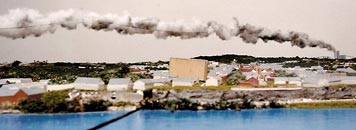
Photograph of a model of the St. Lawrence Cement project commissioned by Richard Katzman.
I received an email last week that "The St. Lawrence Cement Plant proposal, which so many residents in the Berkshire Mountains have followed for the last six years, is now in a crucial public comment period..." There was a call to action, of course. Come to the meeting. Give money. Write your Congressman.
St. Lawrence Cement wants to built an enormous cement plant, powered by coal and the burning of tires and medical waste, on the Hudson River, about 120 miles north of New York City. The stacks on this plant will be 406 feet tall — being on a hill they will loom 600 feet above the Hudson. The plume will stretch 6.3 miles on many days. Up to 20 million pounds of pollution will be emitted from the project, which will burn 500 million pounds of coal annually. Further, the Swiss corporate parent has a terrible track record of pollution and price-fixing violations worldwide. Their cement plant in Texas, built when George W. Bush was governor, is one of the worst polluters in America.
We live 35 miles away, in the Berkshire Mountains that cross the northwest corner of Connecticut, where under moderate wind conditions, pollution will reach us in just about an hour.
Opposition to this project has been strong from the start. Movie stars have sponsored fundraisers and lent their names, including Meryl Streep and Natalie Merchant. Newspapers have written endless editorials. Serious environmental and health groups have weighed in, from the American Cancer Society to the Natural Resources Defense Council to the Sierra Club. Even the local antique dealers association has signed on. Many organizations, however, have larger priorities: the NRDC, for example, is also fighting the Fish and Wildlife Service to block mahogany imports from Peru, urging the Bush administration to be a global leader in mercury reduction efforts, and suing the Environmental Protection Agency for making secret deals with pesticide manufacturers.
When I first heard about this project a number of years ago, I urged the opposition leaders to find a way to visualize the scale of this project and to dramatize the scope of the pollution. There have been many efforts to do this.
There was the balloon-flight test to demonstrate the height of the towers and its resultant "blight on the landscape." There have been photo stimulations, photographs of modeled plumes, parties where the building columns illustrated the stack height, new taglines, and threats that the plant will ruin historical sites. There have been posters by nationally recognized designers and by local artisans, as well as billboards. There are other "Stop The Plant" movements to learn from: the 325 foot stack on the proposed powerplant on the Greenpoint/Williamsburg waterfront in New York City; other cement plants on the Ohio River in Cincinnati and on the Ichetucknee River in Florida; and the "Campaign Against the New Kiln" in Padeswood, Flintshire, UK.
Yet, there is no single rendering ominous enough to establish public fear; no image so compelling as to create political momentum; and no symbol so memorable as to unite the opposition. Whether through artistic renderings or information design, no one has made a visual case against these plants that is wholly effective. This is, I believe, a fundamental failure of design.
Architects have a long tradition of rendering the future, of creating images that excite the public and unify political interest in building things. Hugh Ferris's studies opened the door to the modern skyscaper. In 1922, even the losing entries for the Chicago Tribune Tower were imaginatively rendered, deeply affecting architectural history for years to come (e.g., Eliel Saarinen and Adolf Loos). More recently, the Freedom Tower was emotionally rendered by Daniel Libeskind (as well as symbolically rendered in its 1776 foot height). Not all these buildings were built. But they excited the public imagination, creating energy and discourse.
My favorite recent example is the commission won by Field Operations / Dillier + Scofidio for the High Line project in Chelsea, Manhattan. The beaches on the railroad tracks near the Hudson River, of course, bring Miami to mind. This is not a project one ever expects to be built with fidelity to the drawings. But these renderings did expand the conception of what disused railroad beds might be, and in the process, they galvanized the public (as well as the politicians). The High Line was saved, in part, precisely because of such images (as well as by the dedicated photographic work of Joel Sternfeld).
Back in the Berkshire Mountains, we're not so lucky. There are no fantasies of Miami on the Hudson here: our future looks quite different. We have only photographic renderings of long plumes of pollution — cotton balls hanging from miniature wires — waxing in the wind of a model.
